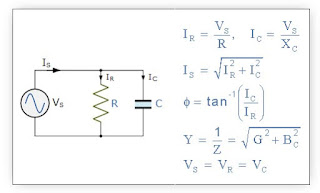The electric current can flow through a circuit in one of two ways. If it flows in a constant direction it is only classified as direct, continuous (CC). If the electric current alternates in both round-trip directions it is classified as alternating current, (AC). Although they present an impedance within a circuit, passive components in alternating current circuits behave very differently from those in DC circuits.
Passive components in AC Circuits consume electrical energy and therefore can not increase or amplify the power of any electrical signals applied to them, simply because they are passive and, as such, will always have a gain of less than one. Passive components used in electrical and electronic circuits can be connected in an infinite number of ways as shown below, with the operation of these circuits depending on the interaction between their different electrical properties.
Passive Components in Alternating Current(AC) Circuits
Where: R is the resistance, C is the capacitance and L is the inductance.
Resistors if used in DC or AC circuits will always have the same resistance value no matter what the power frequency. This is due to resistances that are classified to be pure that have parasite properties such as infinite capacitance C = ∞ and zero inductance L = 0. Also for a resistance circuit the voltage and current are always in phase so that the power consumed at any time can be found by multiplying the voltage by the current at that instant.
The capacitors and inductors, on the other hand, have a different type of AC resistance known as reactance, (X L, X C). Reactance also prevents the flow of current, but the amount of the reactance is not a fixed amount by an inductor or a capacitor in the same way that a resistor has a fixed value of resistance. The value of the reactance of an inductor or a capacitor depends on the frequency of the supply current, as well as on the DC value of the component itself.
The following is a list of passive components commonly used in alternating current circuits together with their corresponding equations that can be used to find their value or short-circuit current. Note that a theoretically perfect (pure) capacitor or inductor does not have any resistance. However, in the real world they will always have some resistive value no matter how small.
Purely resistive circuit
Resistor - Resistors regulate, obstruct or establish the flow of current through a particular path or impose a voltage reduction in an electric circuit as a result of this current flow. Resistors have a form of impedance that is simply called the resistance, (R) with the resistance value of a resistor that is measured in ohms, Ω. Resistances can be of either a fixed value or a variable value (potentiometers).
Purely capacitive circuit
The capacitor - The capacitor is a component that has the capacity or "capacity" to store energy in the form of an electrical charge such as a small battery. The capacitance value of a capacitor is measured in farads, F. In DC a capacitor has infinite impedance (in open circuit), (X C), while at very high frequencies a capacitor has zero impedance (short circuit).
Purely inductive circuit
Inductor - An inductor is a coil of wire that induces a magnetic field within itself or within a central core as a direct result of the current passing through the coil. The inductance value of an inductor is measured in henries, H. In DC an inductor has zero impedance (short circuit), while at high frequencies an inductor has an infinite impedance (open circuit), (X L).
Circuits of Alternating Current(AC) of the Series
Passive components in alternating current circuits can be connected together in series combinations to form RC, RL and LC circuits as shown.Circuit RC Series
Series RL Circuit
Series LC circuit
Parallel alternating current circuits
Passive components in alternating current circuits can also be connected together in parallel combinations to form RC, RL and LC circuits as shown.Parallel RC circuit
Parallel RL Circuit
Parallel LC circuit
We have seen previously that the passive components in alternating current circuits behave very differently than when connected in a direct current circuit due to the influence of the frequency, (ƒ). In a purely resistive circuit, the current is in phase with the voltage. In a purely capacitive circuit of the current in the capacitor it conducts the voltage by 90 o and, in a purely inductive circuit the current is delayed by the voltage of 90 o.
The opposition to current flow through a passive component in an AC circuit is called: resistance, R for a resistor, capacitive reactance, X C for a capacitor and inductive reactance, X L for an inductor. The combination of resistance and reactance is called impedance.
In a series circuit, the sum of the phasors of the voltages across the circuit components is equal to the supply voltage, V S. In a parallel circuit, the sum of phasors of the currents flowing in each branch and therefore through each of the circuit components is equal to the supply current, I S.
Therefore parallel and in series connected RLC circuits, when the supply current is "in phase" with the supply voltage of the resonance circuit occurs as X L = X C. A series resonance circuit is known as an acceptor circuit. A Parallel resonance circuit is known as a circuit that rejects.























No comments:
Post a Comment